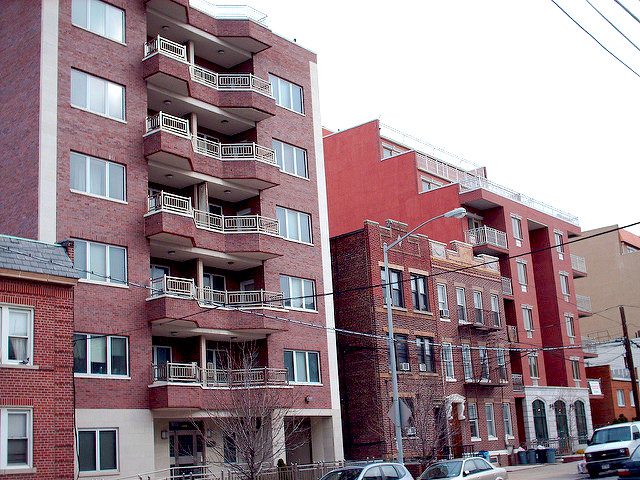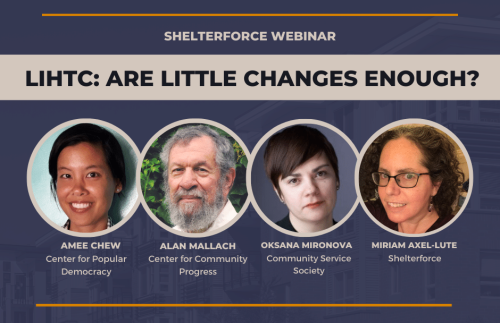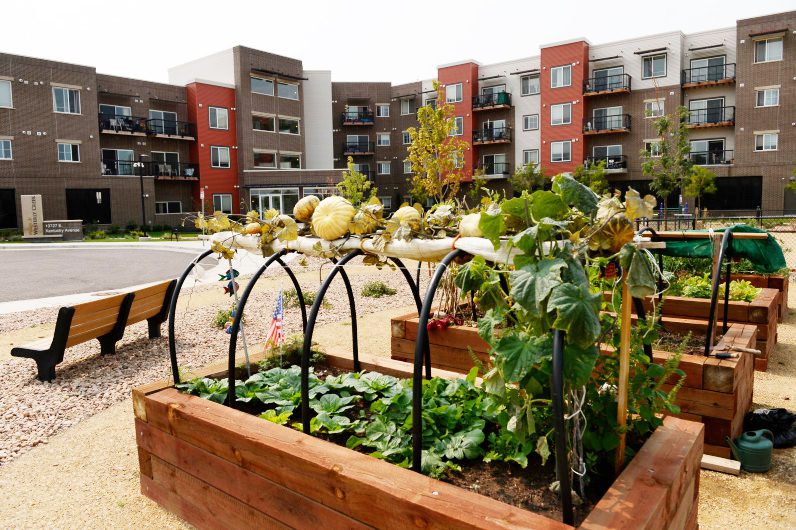
Photo by astoriasunday via flickr, CC BY-NC 2.0
For families lucky enough to benefit, federal rental housing assistance can be a lifeline to stability. Unfortunately, there isn’t enough assistance to go around, and current rent rules leave some families feeling financially paralyzed by a fear of losing assistance or having their rents rise if they get a raise or a better-paying job.
Addressing this dynamic was one of the motivating factors for the creation of the Family Self-Sufficiency (FSS) Program over 30 years ago. Initially restricted to public housing authorities (PHAs), in 2018, Congress expanded the program to private housing providers using project-based rental assistance committed to helping their tenants better navigate their financial lives. If the multifamily affordable housing sector can fully embrace the FSS Program, it has the potential to magnify the impact of subsidized housing, especially for families able to work and increase their earnings.
FSS was based on a good idea—to revise rent rules for families using housing assistance so there are better incentives to work, earn, and save. Normally, rent is set at 30 percent of a family’s income, which means rent goes up when a family earns more. Under the FSS Program, participating families whose incomes rise have the amount of the rent increase diverted into an escrow savings account. Participants sign five-year contracts that identify their financial goals and they are connected to support services while enrolled. These goals can be personalized and flexible, but to graduate—and gain access to the full amount of their accumulated savings—participants need to additionally meet two specific program goals: they must obtain appropriate employment suitable to their skills and education and the entire household must be free of cash assistance, such as TANF. (Food stamps and Medicaid are exempt.) The point of the program is to transform housing assistance so that it works more like a springboard to greater financial security and economic mobility.
‘HUD already has evidence that the program can work for many aspiring families.’
Limited to PHAs and with a relatively small allocation of funding awarded to cover staffing and administrative costs, FSS historically had a low profile in the suite of HUD programs and funding streams. That may be about to change, as Congress has steadily increased funding, and a growing track record of positive results has increasingly attracted the attention of advocates, policymakers, and other affordable housing providers with a shared interest in leveraging housing assistance to achieve better outcomes for families.
HUD already has evidence that the program can work for many aspiring families. In 2021, almost 60 percent of participants accumulated savings in their escrow account while enrolled. Many families choose to tap some of these resources to support pursuing their goals. About one quarter of graduates had residual savings in their accounts in 2021, with an average balance of almost $9,500. For a low-income family, this is a pretty significant sum, especially when it can be used at the family’s discretion to pay bills, manage finances, spend on children, or put toward a downpayment on a home. Program rules are intended to avoid discouraging participation, so FSS graduates are not required to move, even after gaining access to any money in their account. Importantly, for the housing provider, the cost of this escrow account benefit—which is the sum of what’s diverted into the escrow account because a family has raised their income—is covered by HUD. For participants that don’t end up graduating, either because they haven’t found employment or dropped out for other reasons, they still can benefit from receiving support services. Any accumulated funds that are not collected can be used by the provider to benefit other families in the FSS program.
Congress initially created the opportunity for groups to pilot FSS on a limited basis in 2015. In 2018, FSS was reauthorized, and Congress permanently expanded eligibility to private housing providers that were using project-based rental assistance. Initially, no federal funds were allocated for use by these providers to cover staffing and overhead costs, but organizations could apply to HUD so they could offer escrow accounts and support services. In the intervening years, momentum has grown. FSS funding has increased by 67 percent since 2019, rising from $75 million to $125 million in 2023, new program rules were finalized in 2022 to govern implementation, and at the beginning of 2023 the first federal grants to cover administrative costs in multifamily affordable housing FSS projects were awarded.
Despite prevailing congressional dysfunction, FSS has benefited from bipartisan support and its budget is poised to rise more. Its founding advocate was Republican HUD Secretary Jack Kemp and, more recently, state Sens. Roy Blunt (R-MO) and Tim Scott (R-SC) supported reauthorization and extending FSS to multifamily affordable housing providers. The Biden administration has signaled its endorsement, both with a higher budget recommendation and the engagement of senior leadership at HUD. Secretary Marcia Fudge has featured FSS as a central component of her economic justice policy agenda, intended to bridge the wealth gap and help low-income renters build assets. Getting that impact will require the engagement of the multifamily affordable housing sector, which currently serves over 1.2 million families and 2 million people.
The Multifamily Affordable Housing FSS Experience
A small group of multifamily affordable housing providers have already launched FSS programs. These early adopters—like Eden Housing, The Community Builders, Mercy Housing, The Caleb Group, and Preservation of Affordable Housing (POAH)—are the vanguard organizations that aspire to do more for their families than provide a roof over their heads.
Aaron Gornstein, president and CEO of POAH, was part of the push to get Congress to permanently extend the FSS Program to multifamily affordable housing providers. He saw how participants in public housing had benefited and made the case to lawmakers that this tangible asset building opportunity should be extended to all residents receiving housing assistance, including those in one of the 13,000 affordable housing units across 11 states, plus D.C., that POAH owns and operates. Their organizational model is already service-centric, so fulfilling that part of FSS is not daunting, and the ability to offer families access to additional financial resources is attractive. He also wanted the opportunity to see if the mission-driven multifamily affordable housing providers could do it better than housing authorities. POAH has committed to offering FSS to all eligible residents. Between 2016 and 2022, the organization enrolled 560 residents, who collectively saved over $1.1 million.
Early on, POAH saw the value in demonstrating that FSS could work for their residents and serve as a model for other mission-driven multifamily affordable housing providers. They teamed up with Compass Working Capital to administer and evaluate one of their initial programs. Compass is a nonprofit based in the Boston area that offers savings and asset-building opportunities for low-income families, particularly Black and Latinx women with families. Compass pursued partnerships with housing providers as a third-party FSS administrator. Compass coaches help participants manage their finances, including paying off debt, budgeting, and raising their credit scores. An evaluation of Compass-led FSS programs found impressive results: rising credit scores and a lower rate of consumer debt accrual than in a comparison group.
To support organizations that offer FSS, Compass created FSSLink, an online platform that offers webinars, a discussion board, and other resources for program staff. The site has become a primary vehicle for information-sharing among FSS practitioners.
With support from Compass and several membership organizations of mission-driven housing providers, specifically the Housing Partnership Network and Stewards of Affordable Housing for the Future, a discrete FSS field has begun to emerge where organizations can exchange information and best practices. This was important for groups that started pursuing FSS programs without any HUD funds. Their collective experience has demonstrated that launching an FSS program is doable, even if there are challenges. Defined program rules and requirements must be learned and followed, but HUD doesn’t mandate a particular approach.
This means that organizations get to decide what services to offer and how they will be delivered. A broad spectrum of resident services can be incorporated into FSS programs. These include services that promote employment and higher earnings, such as training and job placement, as well as services to overcome barriers to work, including child care, transportation, and substance abuse treatment. Regardless of what specific services are provided, the early adopters have seen benefits when their FSS programs have a specific emphasis, such as financial coaching or employment counseling, and it is aligned with larger organizational goals.
The early adopters recognize that FSS isn’t a good fit for all their residents. It works best for those families with a member of the household who intends to raise their earnings. This might be just a portion of families at a project site, but there is a consensus among providers that it is OK to start small. HUD will provide a grant to cover a staff position for the first 25 families in a program, and funding for 1 position for every 50 families thereafter. The program seems to be an especially good match for people striving to become homeowners. Participating residents who graduate with higher incomes can not only use their escrowed savings as a downpayment, but can also see improved credit scores, which help lower the cost of a mortgage. Recent HUD data confirms the potential of this approach, as 11 percent of FSS graduates had purchased a home.
Another emerging lesson among FSS trailblazers is that resident engagement must be a central activity, not an afterthought. Explaining the program to potential participants is not a simple task and residents must then be convinced that it is worth their while. During the process of outreach and promotion, staff must describe how the program works and its potential benefits. The process of diverting rents into escrow accounts can sound abstract and getting access to the money may seem too good to be true. There are also often significant language barriers to overcome.
Accordingly, specific outreach strategies are necessary to appeal to the wide range of residents who might participate in the program. Organizations that have been successful in enrolling residents have relied on sustained, multifaceted outreach, using mailers, handouts, and testimonials, which can be deployed in different settings, such as at meetings, income recertifications, and community events. The key is to diversify the approach and tailor it to the circumstances of each potential participant. Sometimes the property manager, who interacts with residents more frequently, is better at conveying information than an off-site case manager. Regardless of specific engagement strategies, most organizations learn that the process of implementing FSS is not linear. There can be unexpected delays because of HUD processes, staffing turnover, or changes at the property site, and program administrators must be flexible and open to refining their programs over time.
Complying with HUD rules is an organizational effort. There must be a degree of comfort among organizational leadership with pursuing a program that may initially only benefit a limited number of participating households compared to the total portfolio. Accordingly, the decision to launch an FSS program should be made at the highest level since staff from across the organization will have roles to play. What works best is for each department to be part of the rollout and know its role. Finance and accounting staff have to keep track of the escrow accounts, development staff pitch for funders, and even property staff can use their consistent presence on site to support program outreach efforts. All of these efforts can assist the resident services staff who will likely be responsible for the overall management of the program and should be highly engaged.
The resident services staff is usually responsible for enrolling families, overseeing their participation, and facilitating their graduation. These members of the team must be skilled, dedicated, and able to build a high degree of trust with participating families. The ability to train and retain capable front-line program staff is one of the key variables of success, both for the implementation of FSS and for the entire affordable housing sector, to best support resident families. This work is undoubtedly challenging and requires a high degree of cultural competence, knowledge of public assistance programs, and an understanding of the local landscape of support services. However, it can be especially rewarding to help families move forward and achieve their goals.
Finding the resources to support resident services is no easy feat. Early adopters, who began their programs before any funding was granted to multifamily affordable housing providers, have found that there is no one way to fund the FSS program. Each program needs its own funding strategy. Eden Housing included program costs in the annual budget of the targeted property, POAH tapped resources from its organizational budget, and others, such as Operation Pathway, depended on philanthropy and local fundraising to launch their programs.
Next Steps for Policy and Practice
Since many multifamily affordable housing owners already provide services, their embrace of FSS won’t dramatically increase their costs but would afford them the opportunity to offer more benefits to their residents, which would be covered by the federal government. Any multifamily affordable housing provider is now able to start down this path by submitting an action plan to HUD. However, Congress should match the statutory expansion of FSS to these providers with higher appropriations to cover staffing and other administrative costs. Most of the recent funding increases have been used to support existing public housing authority programs. In the future, the multifamily affordable housing sector should receive the lion’s share of a bigger pie to help get FSS to scale. With HUD’s practice of prioritizing renewal grants, successfully applying for FSS funding can help organizations tap a stable and consistent source of funding, which is otherwise hard to come by. The prospect of future funding that can be used to pay for high-quality staff and administrators should attract the attention of many providers, especially those committed to resident services.
Beyond additional financial resources, reaching the potential of FSS in the multifamily affordable housing sector will hinge on groups being able to develop a set of practices to run an effective program, and then being able to share these broadly across the field. The organizations that already started FSS programs are the ones that see this work as central to their mission. Yet many recipients of project-based rental assistance are for-profit entities that understand that better economic outcomes among their residents are good for the financial performance of the property. They are increasingly interested in enhancing their resident services and some of these for-profit housing firms will likely apply for FSS funding in the future. That is for the best, since from the resident’s perspective their ability to participate in FSS should not depend on who owns the building or what funding stream is used to make rents more affordable. HUD should assume the responsibility to provide tailored technical assistance and timely guidance to the full array of affordable housing providers that can offer FSS programs. This includes both the mission-driven and for-profit segments of the multifamily affordable housing sector as well as public housing authorities, who will continue to administer their own programs but should also expect to work more in partnership with housing providers who accept their housing vouchers. For example, the housing authority can keep track of the escrow payments and rents tied to the voucher and a family’s income, while the multifamily affordable housing provider oversees the resident services delivered to the family on-site.
As more multifamily affordable housing providers launch FSS programs, the industry should use pilots and demonstration projects to analyze conditions under which programs are most effective. And the results should, in turn, inform future policy reform. For example, how do interim withdrawals—where residents can strategically access a portion of their accrued escrow balances before graduation—impact results? Other topics for investigation include the potential of technology to lower program costs, reach more families, and address language barriers, as well as other strategies to achieve scale, such as automatically enrolling residents and allowing them to opt out later.
The FSS Program is poised to grow. Making the most of this opportunity will depend on the increasing participation of the multifamily affordable housing sector and the degree to which it can learn from the experiences of the early adopters. The mission-driven organizations that have started the program have played an invaluable role. They have identified ways FSS can integrate asset building with housing assistance. If done right, FSS can support residents as they pursue their financial security goals, which for some may support their transition away from housing assistance, freeing up resources for the next family in need.





This is jennifer m Greene texting 30 percent is not adorable at all to a homeless person like myself I’m and other people that’s can’t pay no kind of rent because of homelessness for to say on phones and on computers that homeless people and others can’t have a place to live without income pertaining to 30 percent income which should be all homeless people and people in need of housing gets zero on houseing rent a month because of homeless being without occupation or occupations there’s no job training or no paid job training as occupations don’t pay noone their money people work all day without getting paid their money and it’s like what said all year round I’m not trying to start no controversy but please keep it in mind that homeless people don’t have no income they need to be told the right kind of housing programs,where to go to get food like food pantrys in churches and places like the salvation army, places were to go to get vouchers to pay rent each month the buses should be free for homeless people to ride to go get the things thy need and also i do help the people I know thats in need im only one person helping as much as i can so god bless those who do truely help those in need my family is i need of housing were homeless people ourselves could someone help us with houseing please contact me ,call me, text me at 313 205-6380 this is jennifer m Greene texting me and my is in need of winter clothing could someone please help us please text me thanks.
Hi Jennifer, we are sorry to hear about the difficult time you are going through. Shelterforce is a nonprofit media organization and publication dedicated to reporting on affordable housing, housing justice, and community development. While we cannot offer aid directly, our team and a few valuable contributors have put together a list of resources that may be helpful in locating the assistance you need: https://shelterforce.org/need-help-finding-housing/
I was involved in the program and was told that I was contributing to my escrow account every time my rent increased only to find that was a lie. Every time I asked about the balance of my escrow account the answer was put off and put off then when I did get a answer I was advised that I didn’t have nothing in my account even though I successfully completed the program and did everything I needed to do was reporting my income changes my rent was increasing as my income increased and I was advised that the additional money I was paying was being put into that account. When I questioned it I was told that my income disqualified me for a escrow account from the start. I find it hard to believe this because why did it take a little more than 5 years to tell me this. I know I can’t be the only one this happen to but situations like this that are not mentioned
I think these situations should be looked into and why is there not a phone number for us as participants to call and report situations like this? I fell like my case and cases like mine should be looked into and we should still get the money that should have went into our escrow account.
Hello my name is Rose I’m resigning in Denver Colorado I am homeless I stay in a homeless shelter and I’m in all over town put in my name on houses list and so far nothing so I would like to know what would I need to do to get to y’all to get housing or is y’all probably the same program the same people places this is the same thing
Hi Rose, we are so sorry to hear about the struggles you are going through with housing. Shelterforce is a nonprofit media organization and publication dedicated to reporting on affordable housing, housing justice, and community development. As a media organization, while we cannot help directly, our team and a few valuable contributors have put together a list of resources that we hope you may be able to use: https://shelterforce.org/need-help-finding-housing/
This is good for disabled people if the rent isn’t high .but what abaut Florida is it really affordable I was told the low income apartments are $600 to $900 is that really low income I don’t think so I live in arcadia Florida DeSoto county and trust me it’s to high rent people can’t afford that it’s hard enough with food prices so high why are people doing this to us have a heart please